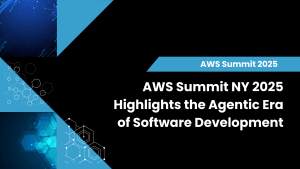IBM’s Future Rests on its Innovation Agenda
IBM’s new CEO has an opportunity to reset the direction of the company. Outgoing CEO Ginni Rommety inherited a strategy put in place over two decades, which fossilized into a lower margin services-led model that she helped architect. Ginni spent a large portion of her tenure shrinking the company so it could grow…unfortunately she ran out of time before she could see that happen.
Decades of Missed Opportunities
For years, IBM has squandered chances to aggressively invest in the key waves that are powering the current tech economy. Instead, it tried to balance investing in future innovation with placating Wall Street. But IBM did invest and has a strong base from which to work if it redirects its use of cash. We believe IBM has an opportunity to return to the Big Blue status that set the standard for the tech industry. But several things must change, some dramatically, for IBM to succeed in this endeavor.
Setting a New Course
Welcome to this special Wikibon CUBE Insights, Powered by ETR. In this Breaking Analysis we’ll address our view of IBM’s future and try to accomplish three things:
- We’ll review IBM’s most recent earnings – the first under new CEO Arvind Krishna – and we’ll discuss it’s near term prospects and try to decode some recent statements by the new leader.
- Next we’ll look at how IBM got to where we are today and review the epic decisions it has made over the past several years.
- Finally, we’ll look at some of the opportunities we see for IBM to remake itself and return to the tech titan that was once revered by customers and feared by competitors.
Early Statements by IBM’s new CEO
Let’s first look at some comments from new CEO Arvind Krishna and try to understand them a bit more and what they mean for IBM’s future.
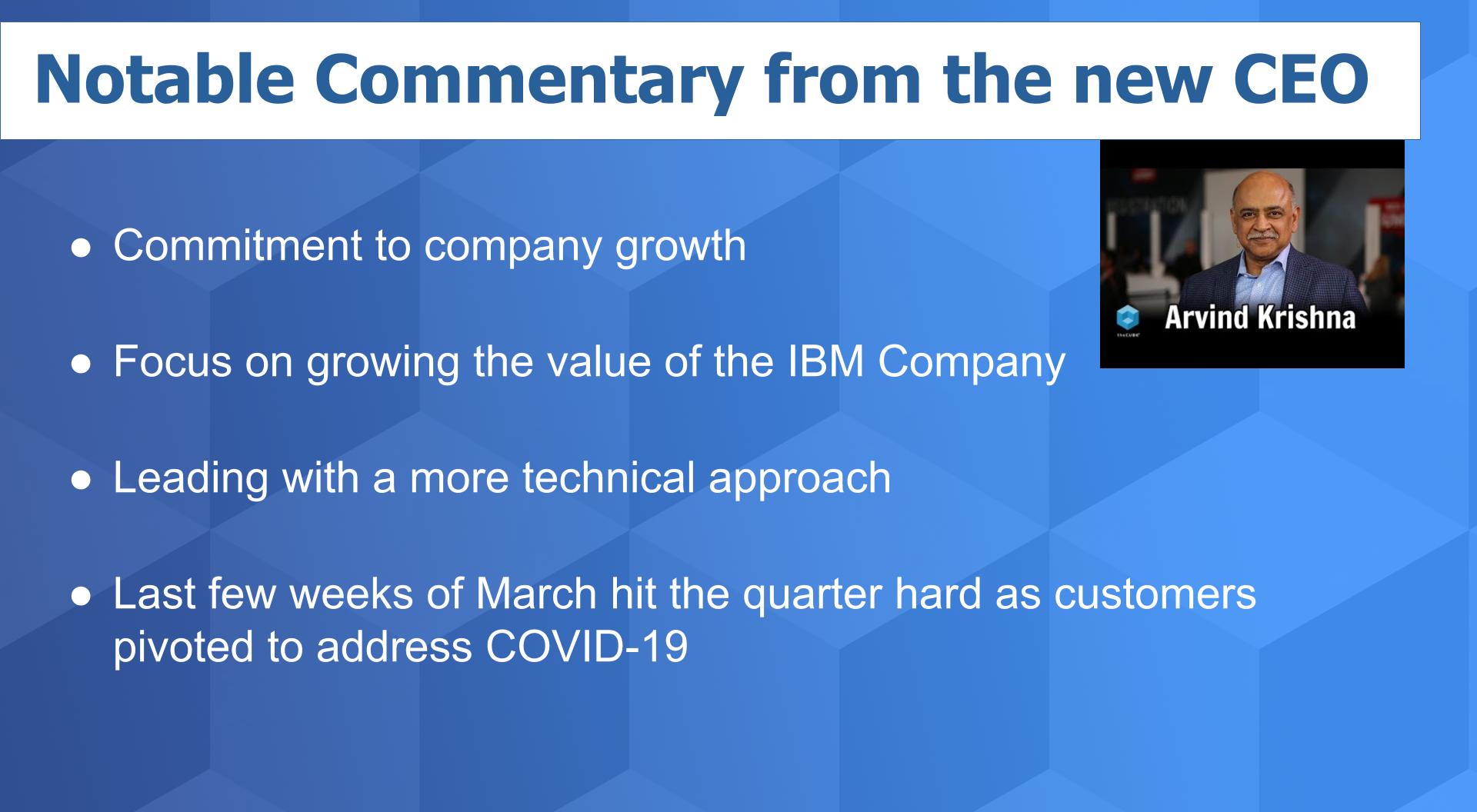
Krishna – in IBM’s earnings call, in interviews and internal memos has given several clues as to how he’s thinking. The slide above addresses a few of the key points. Arvind has clearly stated he’s committed to growing the IBM Company and increasing its value. This is not surprising as all IBM CEOs have been under pressure to do the same. But saying and doing as we know are two different things. We’ll look into that further later on in this segment.
Arvind stated that he wants the company to lead with a technical approach. As we reported in January when Krishna was appointed CEO, we are encouraged that IBM chose a technical visionary to lead the company. Arvind’s predecessors did not have the technical depth needed to make the bold decisions that we believe are required to power the company’s future. As a technologists, we believe his decisions will be more focused on bigger technical bets that can pay larger returns; perhaps with more risk.
As a point of tactical commentary, IBM noted that it was doing well coming into March but software deals especially came to a halt as customers focused on managing the pandemic. This is of near term concern and we have little doubt IBM is carefully watching and managing this dynamic to the best of its ability.
Q1 Highlights in Brief
The chart below pulls some of the data from IBM’s quarter – We’ll make a few comments here:
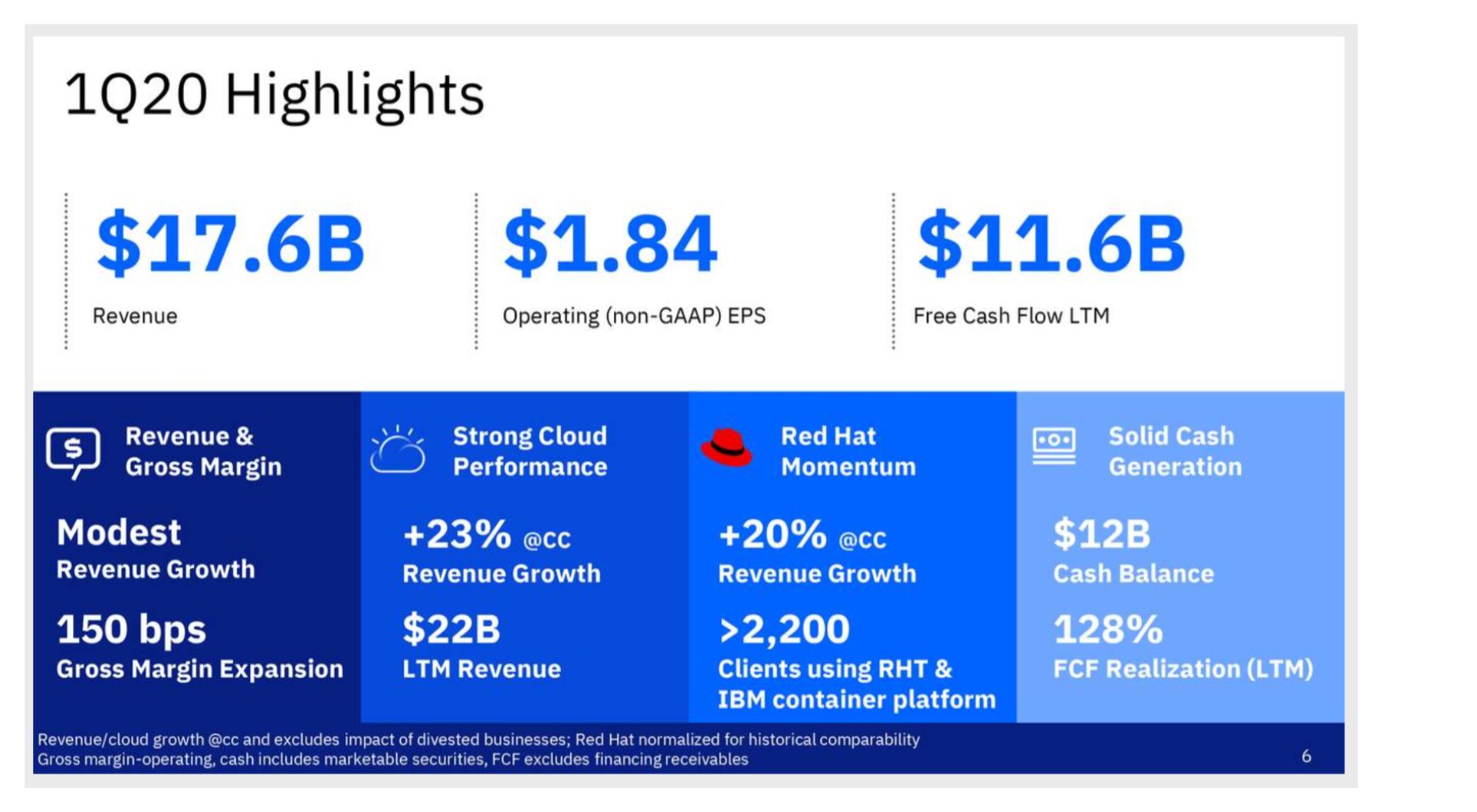
IBM cites “modest revenue growth” on this slide. But revenue was down 1.5% for the quarter (constant currency) relative to last year so we don’t understand “growth.” Cloud revenue for the past twelve months was $22B and grew 23%. We’ll unpack that in a moment. Red Hat showed good growth and IBM continues to generate solid free cash flow.
IBM like many companies prudently suspended forward guidance. Some investors bristled at that but we have no problem with it. There’s too much is uncertain right now and it’s the right thing to do.
Breaking Down IBM’s Business Segments
Let’s look at how IBM’s business segments performed and make some additional comments:
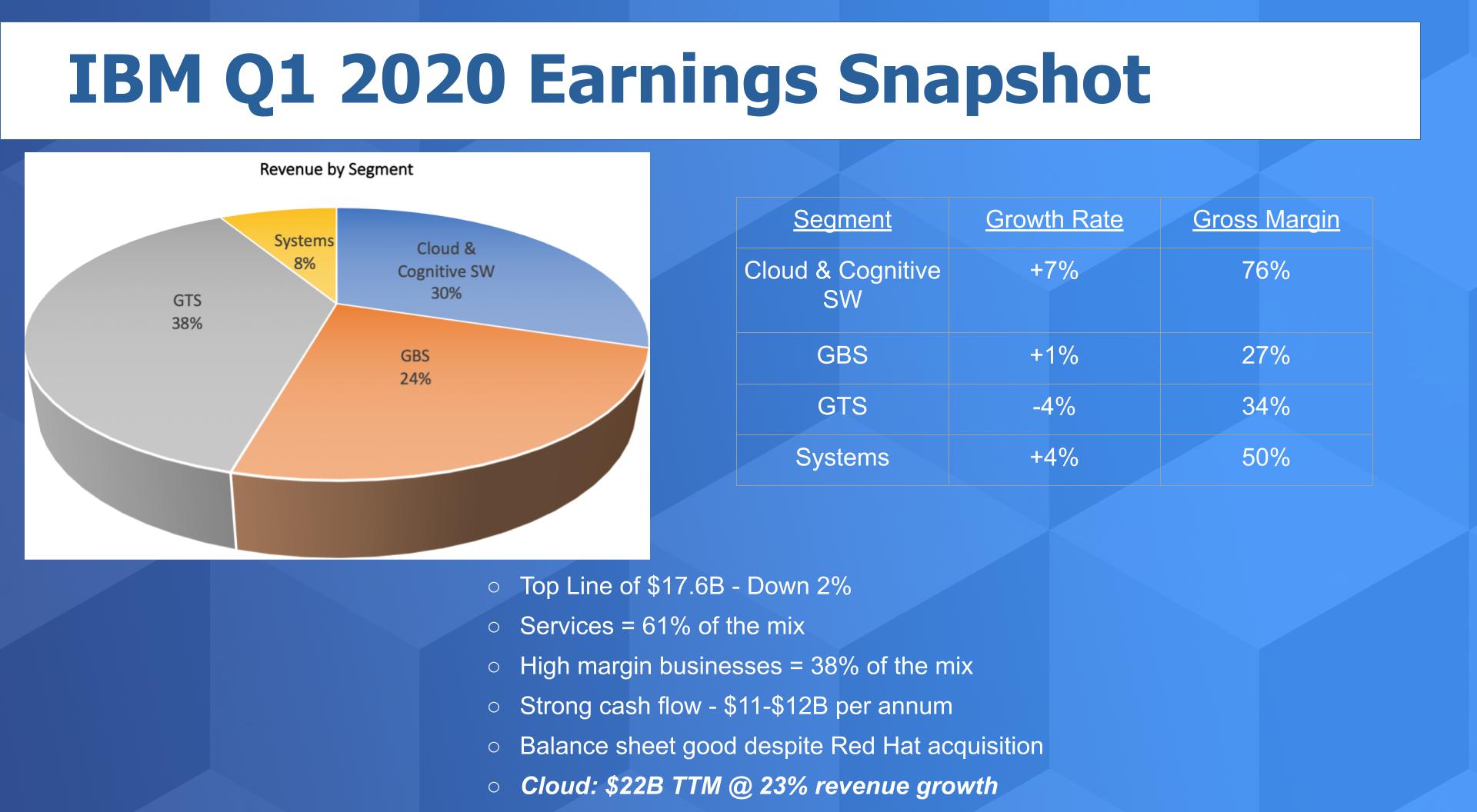
As you can see in this graphic above, IBM’s $17+B in revenue comprises four reported segments.
- Cloud and cognitive software, which is its highest margin (76%) and best growth (+7%) business by far. But only comprises 30% of the pie.
- Two services division – GBS and GTS, which are low growth / no growth businesses that are relatively low margin operations – but together they comprise more than 60 percent of IBM’s business.
- Systems grew nicely on the strength of the Z15 product cycle…Z was up 60% and dragged storage with it…unfortunately Power had a terrible quarter and hence the 4% growth in Systems overall. But decent margins compared to services.
IBMs balance sheet looks fine – it has good liquidity and IBM took advantage of low rates and issued $4B in commercial paper.
A note on services. Arvind mentioned services as an enduring platform for IBM and he’s right. Services gives IBM world class coverage and deep industry knowledge. But services margins are low, it has diseconomies at scale and compresses IBM’s revenue multiple and subsequent valuation. To secureIBM’s future, the company must dramatically grow other parts of its business in our view.
$22B in Cloud – Huh?
IBM reported that its cloud business generated $22B in the past twelve months. It claimed that business is growing at 23%. Your reaction perhaps like ours is “no way.”
The following graphic explains:
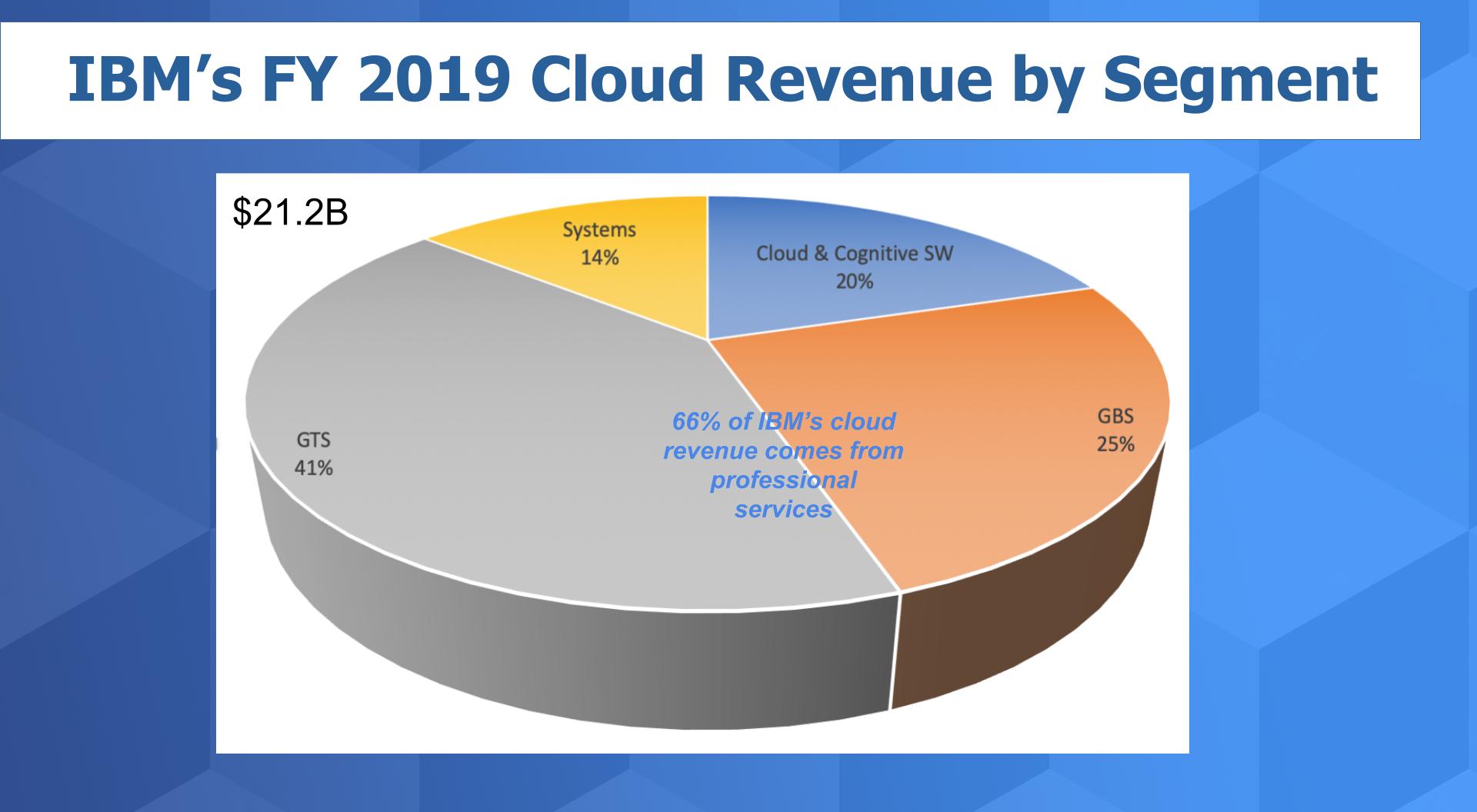
This chart above shows the breakdown of IBMs cloud revenue by segment for FY 2019. As you can see – the Cloud and Cognitive segment (which includes Red Hat) comprises only 20% of IBMs cloud business. The business IBM calls “cloud” only accounts for 20% of its cloud business. We agree, that’s strange.
Professional services accounts for 66% of IBM’s cloud revenue with Systems at 14%. In our view, IBM’s future depends on decreasing its reliance on services and building up more profitable, scalable and higher margin parts of its business.
IBM is defining cloud differently than most people. As a benchmark, what percent of the cloud business of AWS, Azure and Google Cloud – the generally accepted cloud leaders – comes from professional services and on-prem hardware?
In our view this breakdown just doesn’t have real meaning and we think hurts IBMs credibility as it hides the ball on cloud. Nobody believes this number reflects what customers consider cloud. Cloud in this definition is whatever IBM says it is and could include anything.
Customer Spending Data shows a Good News / Bad News Story
Let’s bring in some ETR data and look at the customer spending angle.
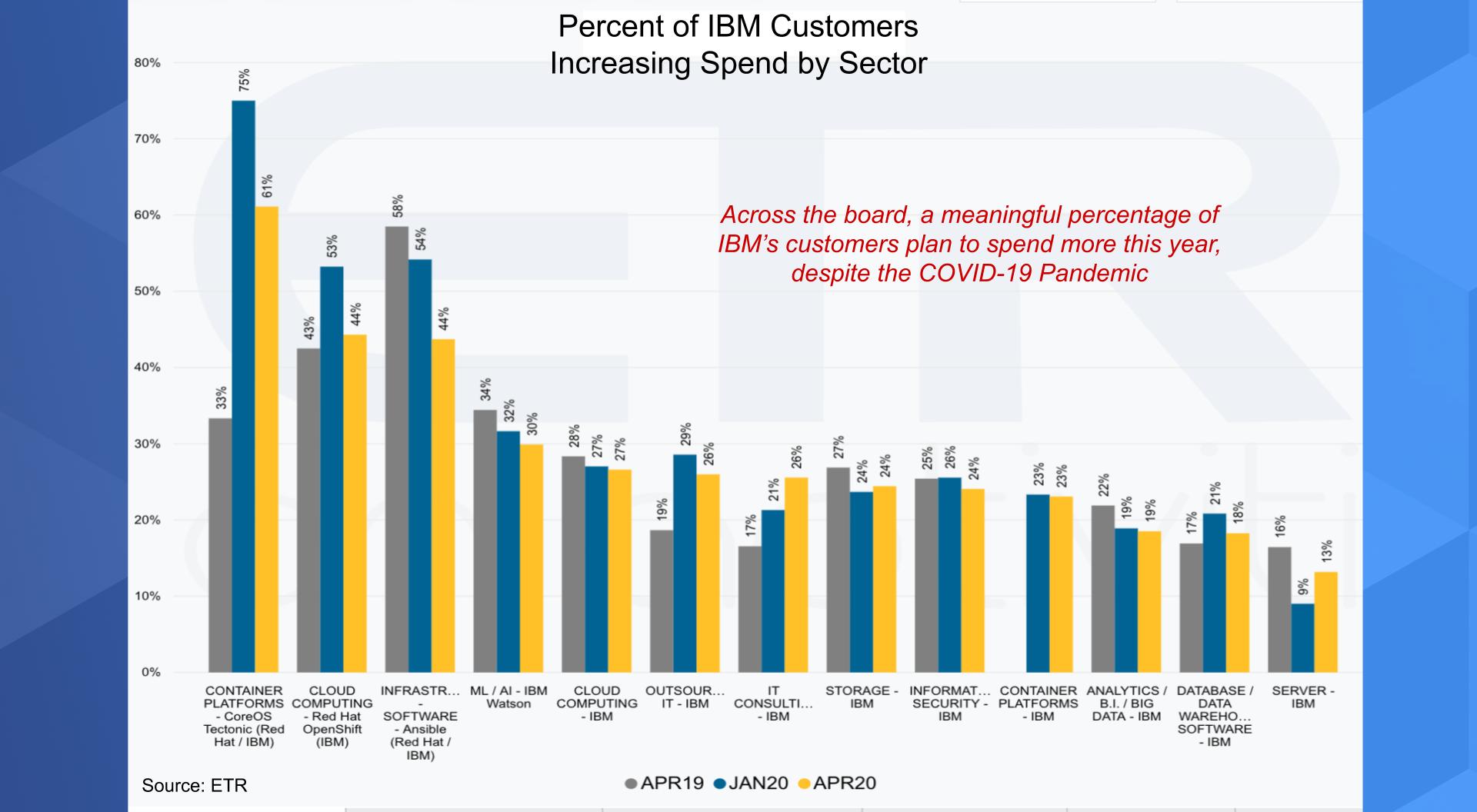
The chart above shows the results of an ETR survey that ran from mid-March to Mid-April. It comprises more than 1,200 respondents and almost 800 IBM and Red Hat customers within the sample. The graph shows the percentage of customers spending more on IBM products by segment across three survey samples – April last year, Jan 2020 and the most recent April 2020 survey. The key point to remember is this survey was taken at the height of the COVID-19 pandemic in the U.S. (note this is a global survey).
Positives
On the plus side, container platforms, OpenShift, Ansible, the staples of Red Hat, are showing nice strength within IBM’s portfolio– even though they are notably down from previous surveys. But that’s the part of IBM’s business that is promising and one reason it acquired Red Hat.
AI ML and Watson is in the positive mix as is cloud. Even outsourcing and consulting has some positives and across the board you can see a respectable percent of IBM customers plan to spend more with IBM in 2020. That bodes well for IBM’s future.
Negatives
So that’s good. But if you look at the Net Scores across IBMs portfolio it’s not all rosy. Remember Net Score is a measure of spending momentum derived by essentially subtracting the percent of customers spending less from those spending more. It’s a nice simple metric – sort of like Net Promoter Score (NPS). ETR surveys using the exact same methodology each quarter for consistency.
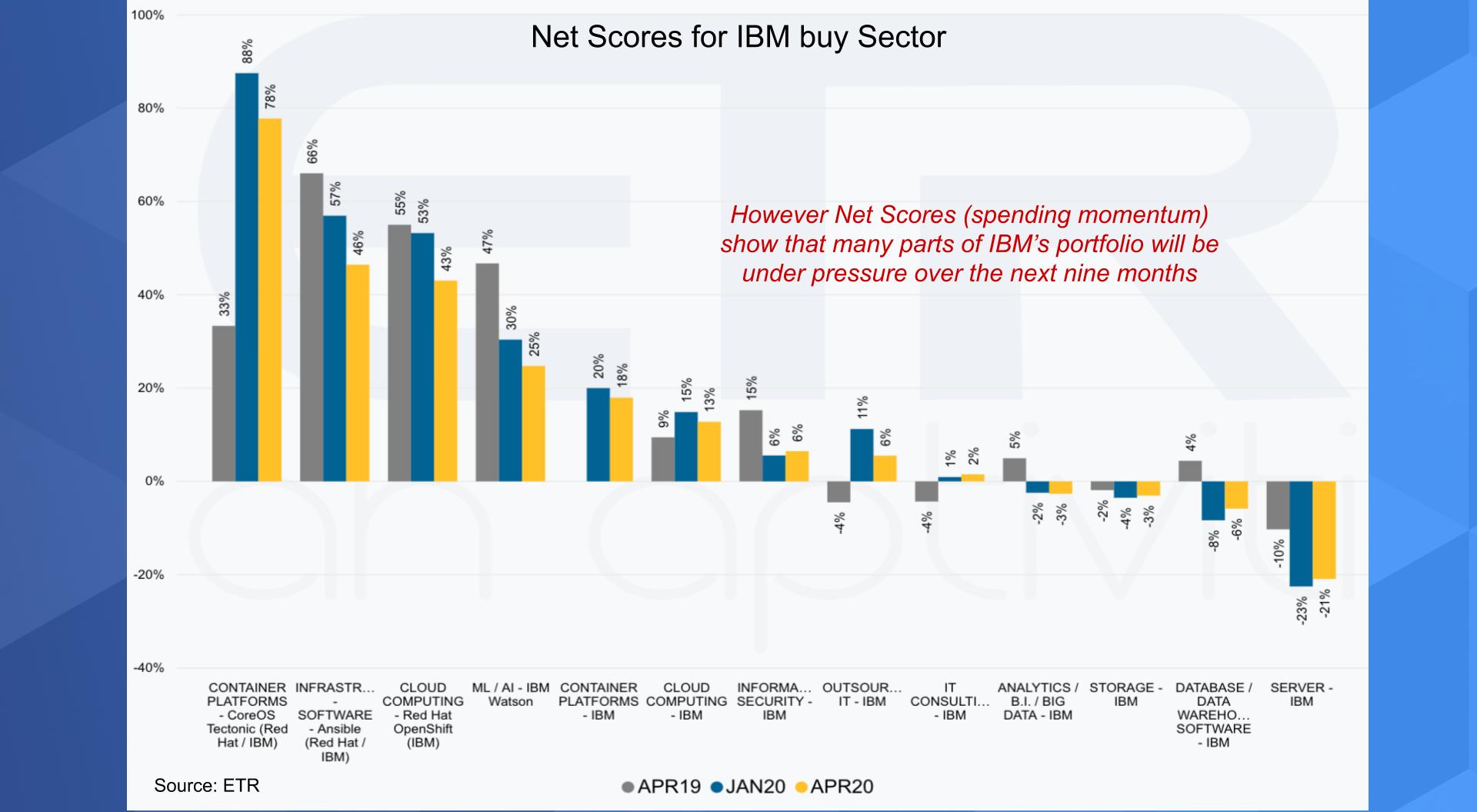
The chart above shows a more complete picture.
You can see here that Red Hat remains the strongest part of IBMs portfolio. But generally in our experience as Net Scores start to dip below 25% you get into the danger zone. So you can see many parts of IBMs portfolio are showing softness and even though as you see here the outsourcing and consulting business are up relative to last year, if you slice the data by large companies – as we showed you last week – IBM’s services businesses are showing deceleration along with Accenture, EY, Deloitte and others.
So the takeaway here is Red Hat is where all the action is and that’s where IBM is going to invest heavily in our opinion. We’ll talk more about that later when we dig into what it means forIBM’s future.
Where will Arvind Take IBM?
Let’s circle back to Arvind Krishna because he has a chance to pull off a Satya Nadella like turnaround. Different, of course. Satya Nadella, when he took over Microsoft as CEO, had access to a balance sheet with $87B in cash. But there are similarities in that you have two great companies in IBM and Microsoft that lost their untouchable status. Microsoft has gained it back under new leadership and IBM has a chance to similarly repeat the comeback. And of course there’s the India-born CEO angle– pretty impressive what’s happening in the U.S. right now.
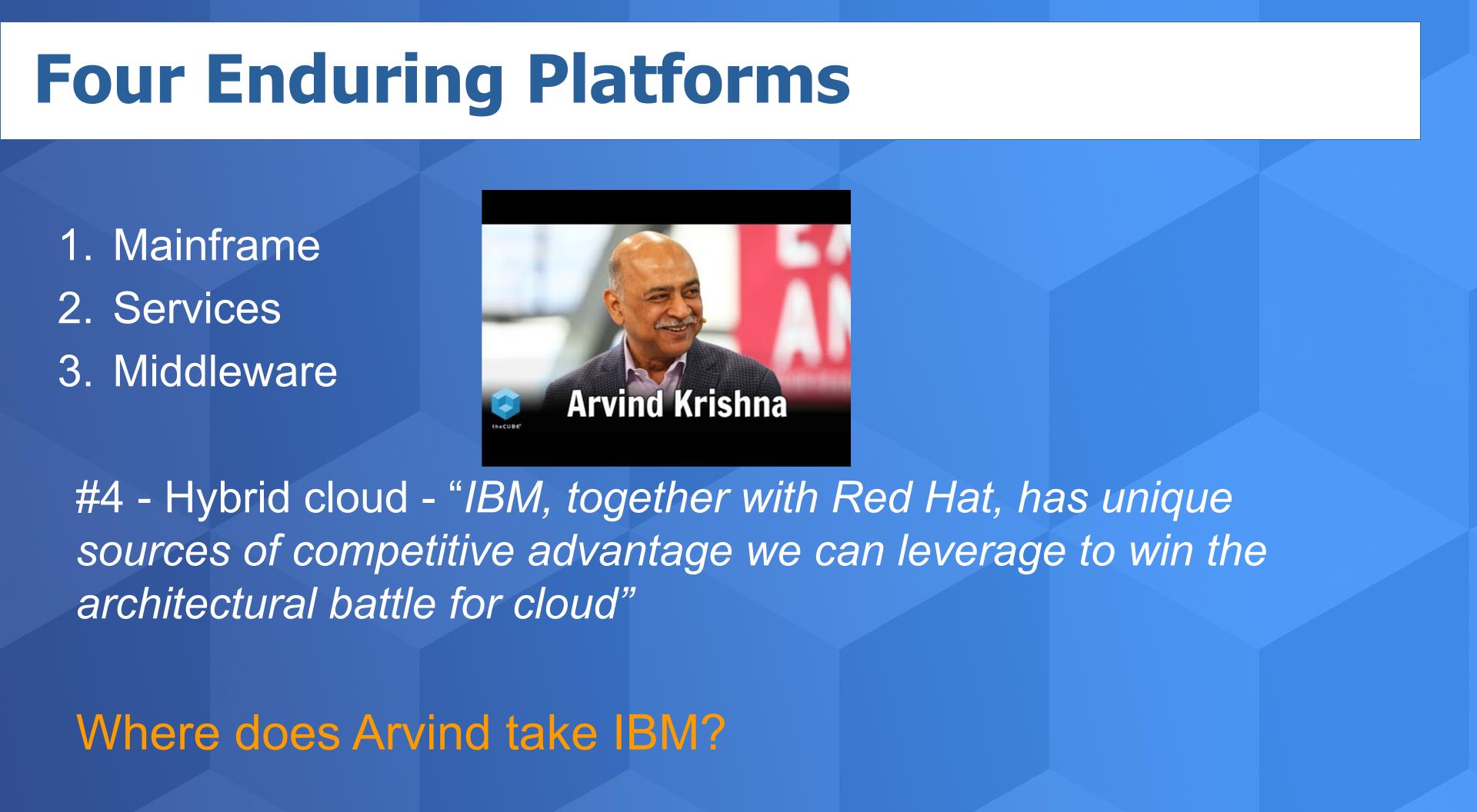
Arvind has cited four enduring platforms for IBM. Mainframe, Services, Middleware and the newest – Hybrid cloud. He has said that IBM must win the architectural battle for cloud. We are going to share later what we think that means. There’s a lot in that statement including the role of AI and the edge – both which we’ll address in this segment.
IBM must win the architectural battle for cloud. -Arvind Krishna
But before we go there we want to understand from a historical perspective how we got here and the opportunities Arvind has ahead. Importantly, we believe he must take much bolder steps than his predecessors to secure IBM’s future.
Let’s look back over the modern history of IBM, meaning the post-mainframe dominance era, which started in 1993 when Lou Gerstner took over.
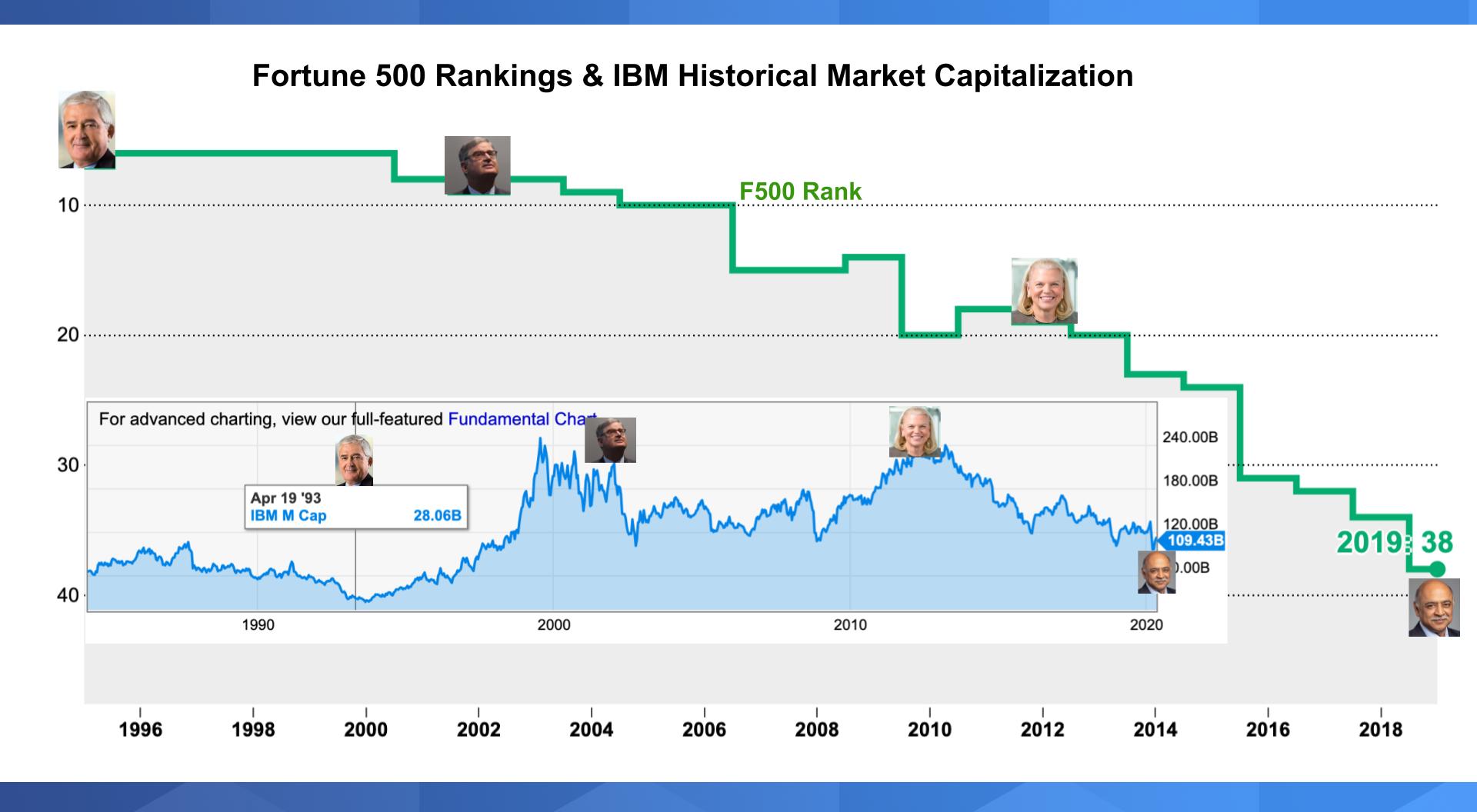
The story in the above graphic has been pretty well-documented but it’s worth exploring from a current market context. The data shows IBMs rank in the F500 in the green line over time…It was 6th under Gerstner, and today IBM is number 38.
The blue area chart on the insert shows IBM’s market value over time. Gerstner was a hero to Wall Street and IBM’s performance under his tenure was stellar. But history is now beginning to fully understand the decision Lou Gerstner made to pivot into services. By turning the company into a services-led firm (further accelerated by the acquisition of PwC under Sam Palmisano), IBM lost its product edge. Ginni, who architected the PwC deal, inherited from Palmisano a portfolio that she had to unwind and hence the steep revenue declines as she jettisoned so-called non-strategic businesses.
But that’s only part of the story…what does the past say about IBM’s future?
The R&D Conundrum
The chart below shows IBM’s breakdown of cash use between 2007 and 2019. The blue is cash returned to shareholders, the orange is R&D spend and the gray is CAPEX. We chose these years because we can all agree that this was the period of tech defined by cloud. And you can see that during those critical early formative cloud years, IBM consistently returned well over 50% and often 60%+ of its free cash flow back to shareholders in the form of dividends and stock buybacks.
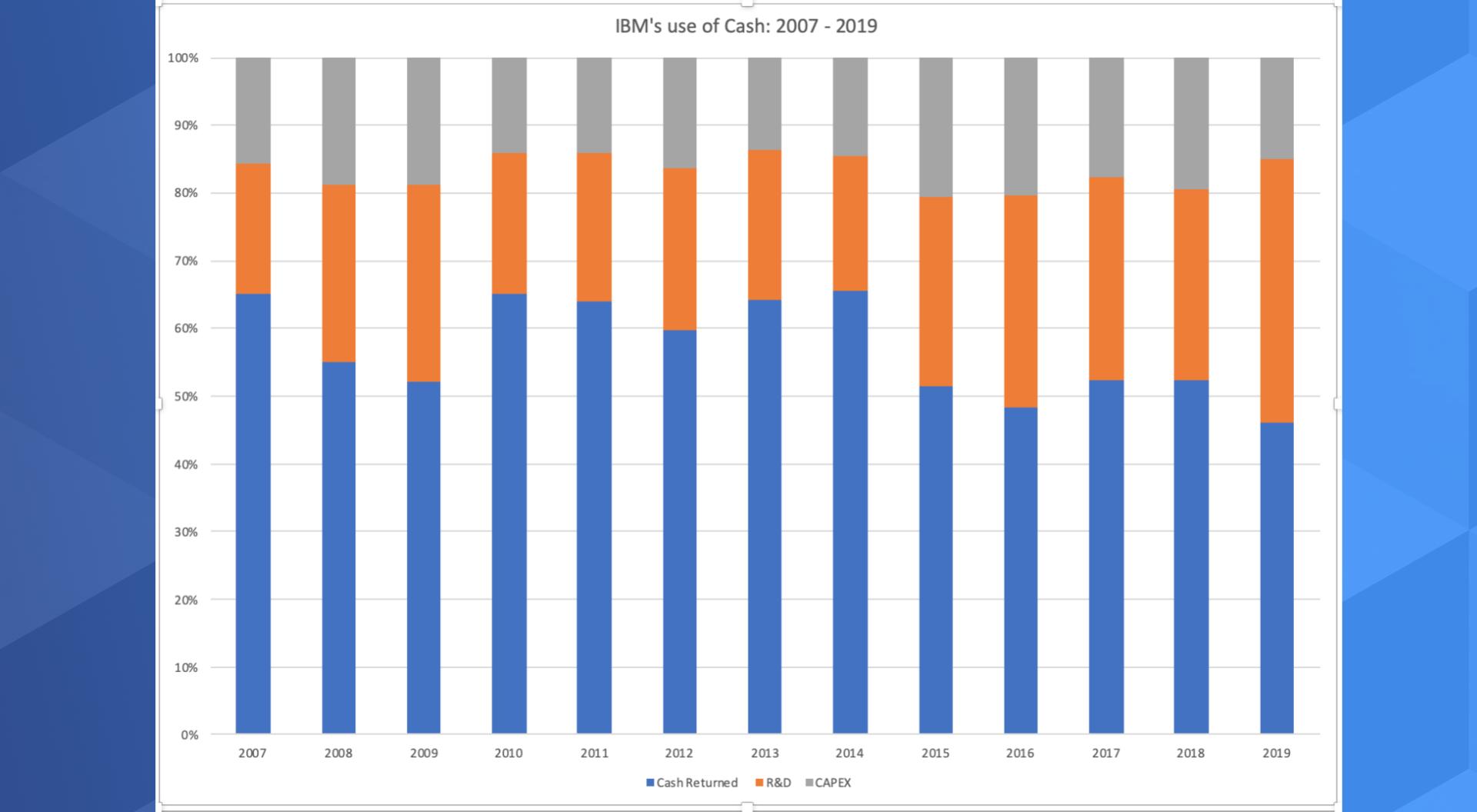
And while the orange bar appears to grow it’s because of what you see in the chart below. It’s a double Y-Axis chart showing IBM’s revenue in the orange and R&D spend in the blue ($B on the left axis). The line shows the % of revenue spent on R&D.
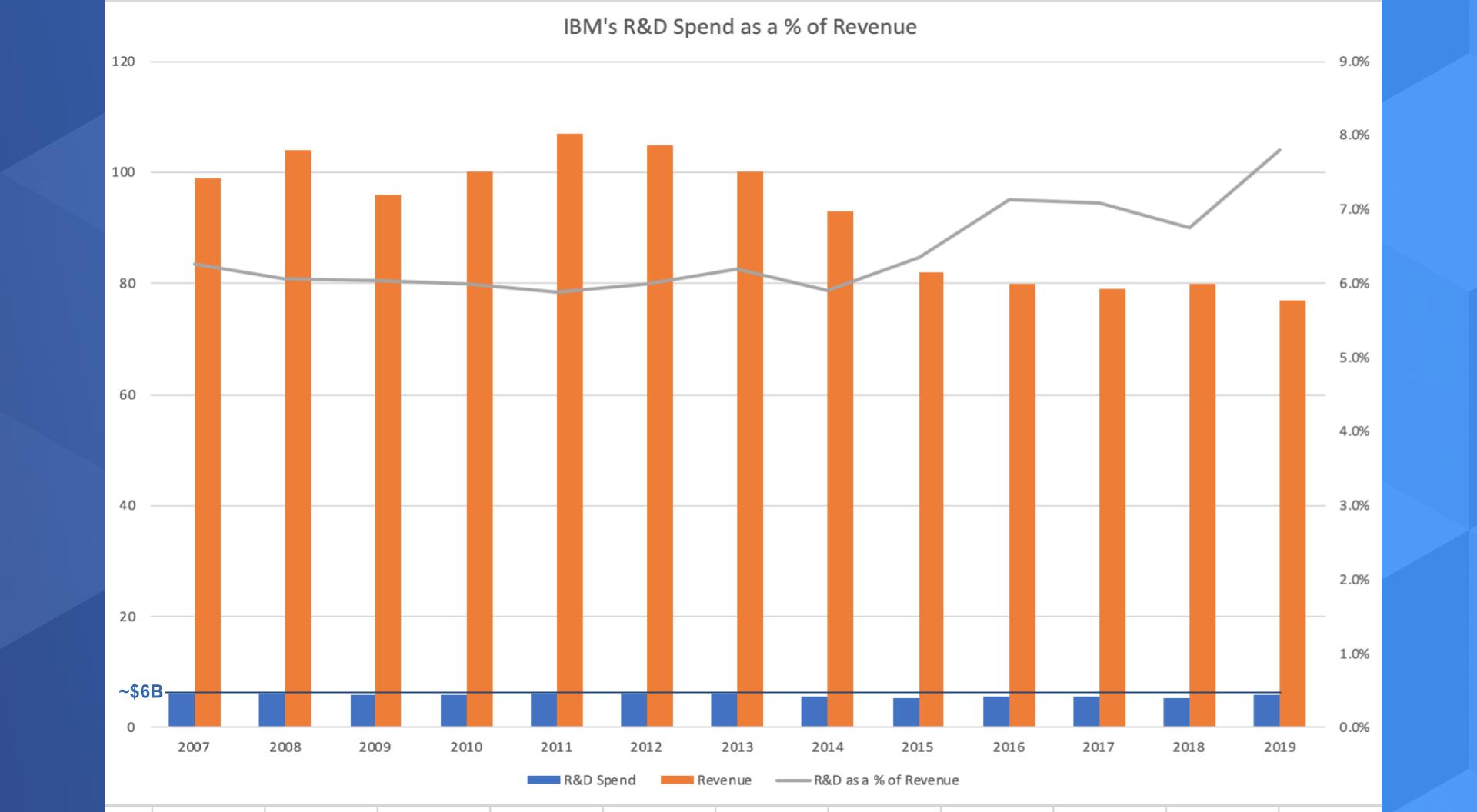
The absolute R&D spend didn’t really grow…it pretty much hovered around 5.5 to 6 billion annually. The percentage grew as IBMs revenue declined. Meanwhile IBM’s competitors were allocating precious capital to R&D and CAPEX, building out the cloud. These choices set the stage for IBM’s future.
Investments in Cloud Buildout
For reference, in 2007, IBM spent $6.2 billion on R&D. Microsoft spend $7B that year. Intel $6B. Amazon spent $800 million and Google spent $2B in 2007.
That same year IBM returned nearly $21B to shareholders.
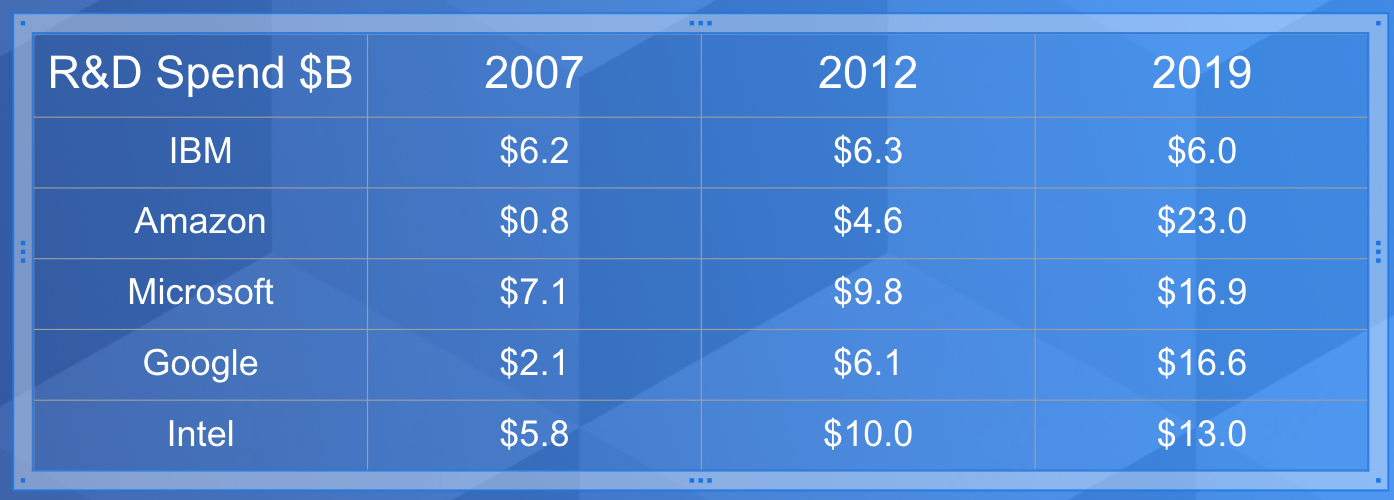
In 2012, IBM spent $6.3 billion on R and D. Microsoft that year…$9.8B. Intel $10B, Amazon $4.6B, Google $6.1B.
IBM returned almost $16B to shareholders in 2012. The following year IBM acquired SoftLayer for $2B and formed a cloud division.
By 2019, the picture changed dramatically. IBM spent about the same $6B on R&D last year. Around the same figure as Cisco and Oracle. Meanwhile Microsoft and Google are spending nearly $17B each, Amazon $23B. IBM could only return $7B to shareholders last year.
So while IBM was returning its cash to shareholders, its competitors were investing in the future of cloud and are now reaping the rewards.
Since 2007, IBM has returned more than $175B dollars to shareholders.
Now in fairness, these numbers don’t include acquisitions, which are a form of R&D for sure. And IBM could argue that it piled another $34B on top of its $6B last year to acquire Red Hat. But that’s not organic research. Organic invention is the lifeblood of innovation. If the company had re-prioritized its cash use, it might have meant a different outcome for IBM’s future.
IBM suspended its stock buybacks after the Red Hat deal. Good. Buybacks have been a sub-optimal use of cash for IBM in our view. Recently IBM raised its dividend by a penny. It did this so it could say that it has increased its dividend 25 years in a row. Ok. We’ll give IBM a “golf clap” for that one. And at the end of the day it’s not an expensive move for IBM. Investors were disappointed that the number wasn’t bigger.
We say “hooray” to that.
The Opportunity Staring at IBM
Somehow Arvind Krishna has to figure out how to tell Wall Street to expect less while he invests in the future. Let’s talk about that…
As we’ve reported before, here is the opportunity.
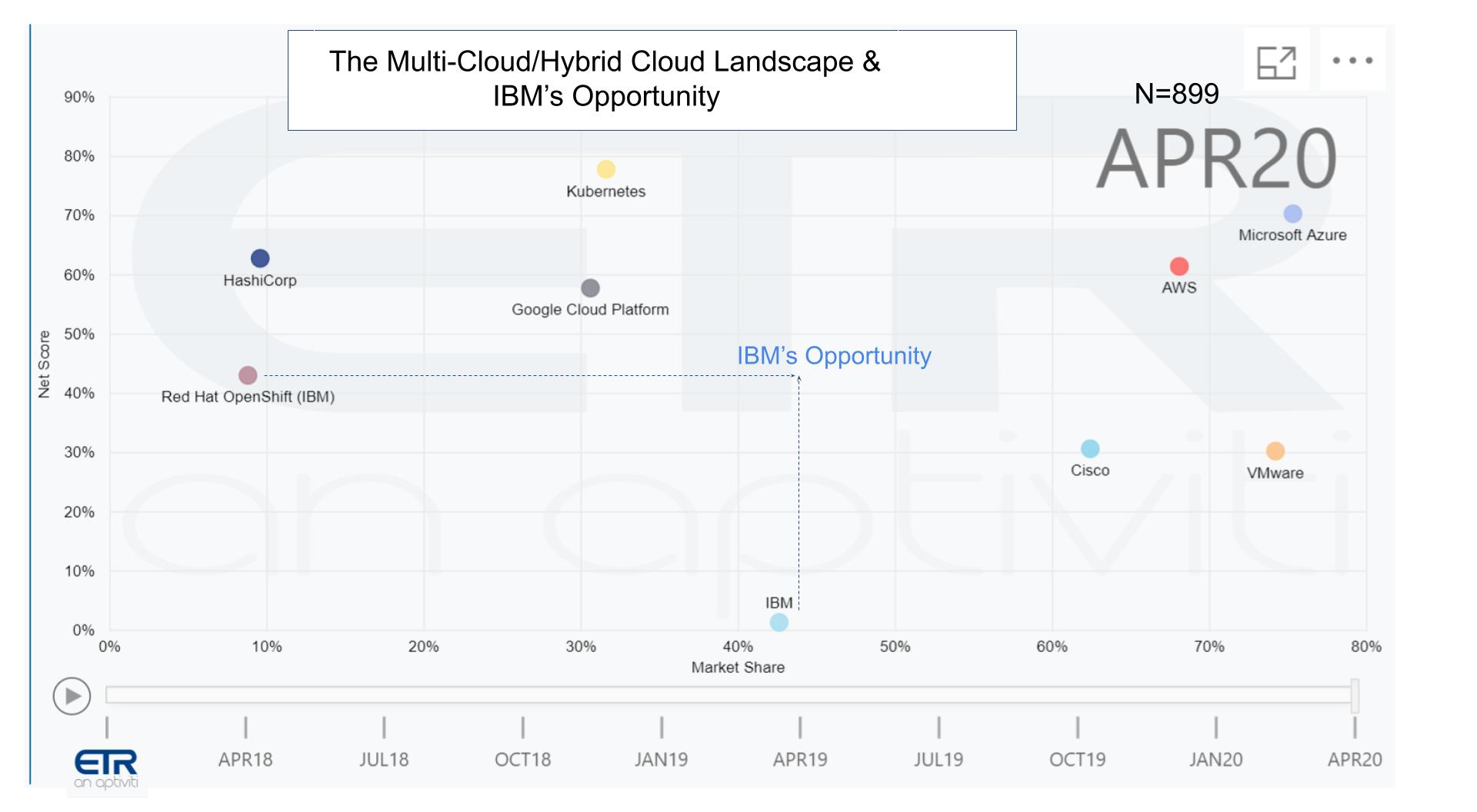
The chart above shows data from ETR. It plots the cloud landscape and is a proxy for multi- and hybrid cloud. It shows Net Score or spending momentum on the Y-Axis and Market Share – which isn’t real marketshare – it’s a measure of pervasiveness in the survey – on the X-Axis. And we’re showing various competitors in the mix (including Kubernetes spending, which we know isn’t a company).
The point is, IBM has presence, Red Hat and OpenShift have relevance and spending momentum. Arvind’s opportunity is to plug OpenShift into IBM’s large installed base to increase Red Hat’s pervasiveness, while lifting IBM’s momentum and relevance to buyers.
This in our view, as we reported last week at the Red Hat Summit, puts IBM in a leading position to go after multi- hybrid cloud and the edge.
The Multi-, Hybrid, Edge “Cloud” Opportunity
Let’s further break down a couple of areas of potential for IBM Red Hat and what it means for IBM’s future.
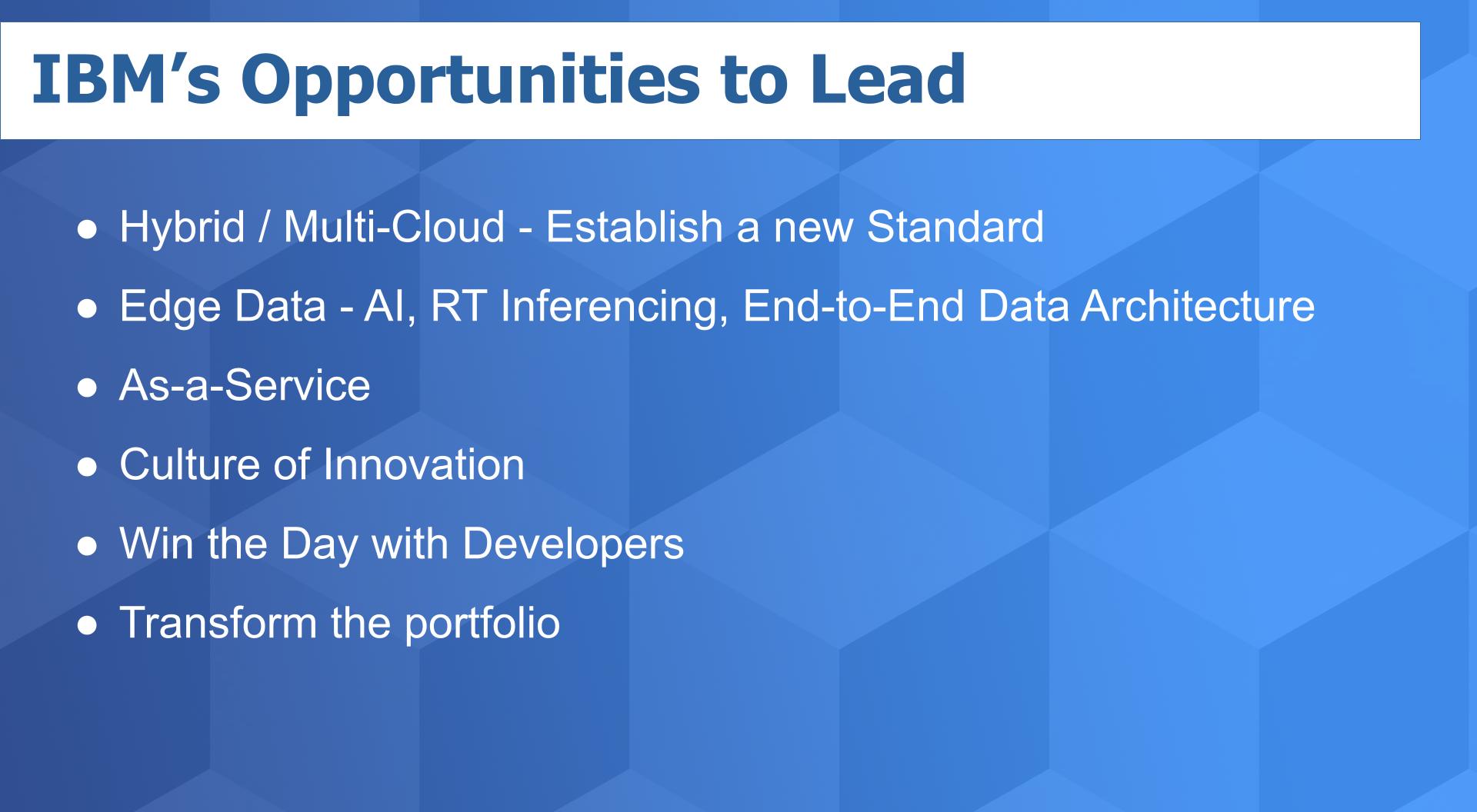
When Arvind talks about winning the architectural battle for hybrid cloud…here’s our interpretation. Enterprises want the ability to run any cloud-native application anywhere agains any data. They need to be able to manage this interconnectivity using the same set of tools at every point in the network.
The ideal interconnectivity architecture layer would be open standards on open source. No one would completely trust Alibaba, AWS, or Microsoft to develop this standard. IBM and Red Hat are in a unique position to create the de facto standard for integrating cloud and hybrid cloud. This includes on-prem, public cloud, cross clouds (multi-cloud) and the edge.
The opportunity is to have the OpenShift container platform provide the interconnectivity and sets of services natively everywhere. On premises, in the AWS cloud, the Azure cloud, on GCP, on Alibaba, of course on the IBM cloud, the Oracle cloud…everywhere. Natively so it can take advantage of the respective clouds’ services at a primitive level. With efficiency and low latency. Same thing for on-prem…same thing for the edge opportunities which we’ll discuss more in a moment in terms of what it means for IBM’s future.
Think of the entire interconnectivity set of IT services (the IT stack) provided natively based on OpenShift. The control plane the security plane the transport, the data management plane, the network plane the recovery plane…every plane. A Red Hat led set of services to allow the distributed management of resources that is 100% identical everywhere. And it’s open source.
IBM can be the independent broker of this open source standard covering as many uses cases and workloads as possible.
This will require an enormous amount of R&D. Think about all the startups building cloud native services and imagine IBM building or buying to fill out that IT stack of services.
Edge Opportunities Require new Thinking
In this post we don’t have enough time to go too deep into other areas but we want to address the edge and weave in AI…beyond what we laid out above, which includes the edge and its impact on IBM’s future.
The edge is a huge opportunity but IBM and most other traditional players we think are missing the boat. Going forward, many enterprises will have more than 70% of data created at the edge. These edge locations and will be running applications against this data performing AI inference in real time. This is going to incredibly challenging.
Think about this. A car running inference AI generates one billion pixels per second today. In five years it will be 15 times this figure. The pressure for real time analysis at the edge will be enormous and require new architectures with different processing models than used in data centers today – likely ARM-based systems.
A car running inference AI generates one billion pixels per second today. In five years it will be 15 times this figure.
IBM has the opportunity to build end-to-end solutions, powered by Red Hat, to automate the data pipeline from factory to data center to cloud and everywhere that instrumented infrastructure lives. Rather than toss traditional Intel-based IT hardware over the fence to the edge, IBM can develop specialized systems and make new silicon investments that can power the edge with very low cost and efficient systems that process data faster in real time.
Briefly we want to touch on three other factors to watch as indicators of IBM’s future, including:
- IBM transitioning to a recurring revenue model…back to the future here. IBM used to have a massive rental revenue stream in mainframes. In the late 1980’s it began strong-arming its customers in a massive financial engineering exercise to convert that base to sales and boost its income statement.
- If Arvind can recreate a culture of innovation and;
- Win the day with developers via its Red Hat relationships…as we’ve said recently he’ll be CEO of the decade.
But he has to transform the portfolio by investing heavily in R&D. Somehow he has to convince the board to stop pouring money back to investors for a number of years and do whatever they have to do to protect the company from corporate raiders.
One has to wonder if IBM has the stomach for this. It’s so straightforward for IBM to continue to milk the cow for decades more. Plodding along, making nominal investments in key areas, hyping things like Quantum that won’t be here for a long time, but are really cool, buying companies to fill gaps and creating more complexity for its customers that its services arms can integrate.
It’s actually not a bad plan. It’s safer and definitely lucrative. Just don’t try to kid us (or yourself) that it’s a growth plan for IBM’s future.
In future episodes of Breaking Analysis, we’ll continue digging into the latest ETR survey data and plan to focus on several other sectors including database, networking, CDNs and WFH infrastructure trends, along with many others.
Remember these episodes are all available as podcasts wherever you listen.
Ways to get in touch: Email david.vellante@siliconangle.com | DM @dvellante on Twitter | Comment on our LinkedIn posts.
Also, check out this ETR Tutorial we created, which explains the spending methodology in more detail.
Watch this week’s full video analysis:


